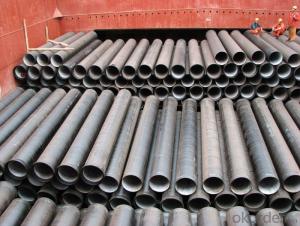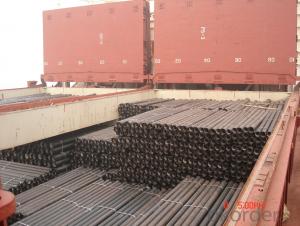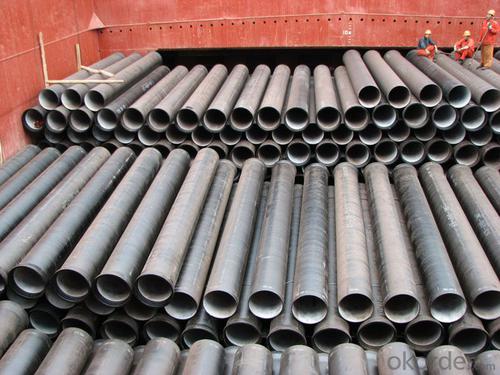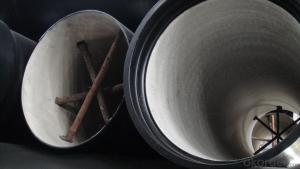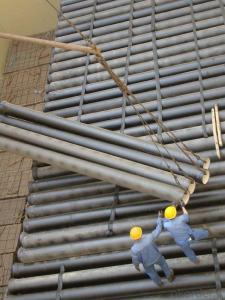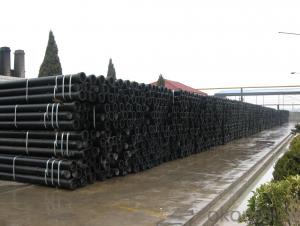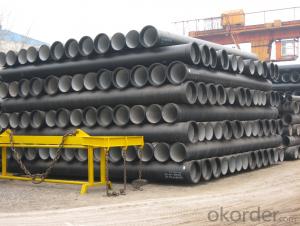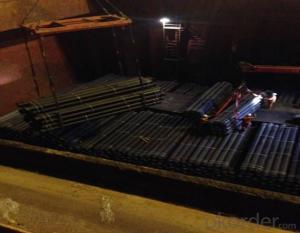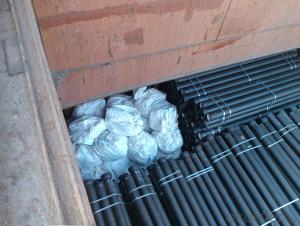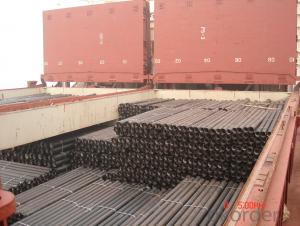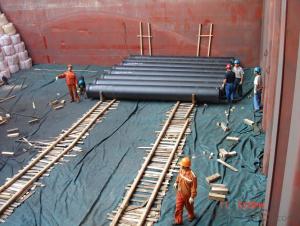DUCTILE IRON PIPE DN500 K8/C/K9
- Loading Port:
- China Main Port
- Payment Terms:
- TT OR LC
- Min Order Qty:
- -
- Supply Capability:
- -
OKorder Service Pledge
OKorder Financial Service
You Might Also Like
Specification:
1) The standard of pipe: ISO2531:1998, K9
2) Effective length: 6m
3) Inner cement line: Portland cement line as per ISO4179
4) Zinc coating: at least 130g/m2 as per ISO8179
5) Bitumen painting: at least 70um as per ISO8179
6) With 100% quantity of NBR ring, or SBR ring, or EPDM ring as per ISO4633
7) DN80mm-800mm
8) High strength, lighter than grey iron, good corrosion resistance, no furring, small flow resistance, easy fixing, long life tome about 100 yeas
9) Produced by Hangzhou chunfeng machine
10) Checked by automatic inspection equipment
11) Composition:
Chemical composition | | | | |||
Chemical composition | Ductile Cast Iron Pipe (%) | Grey iron pipe (%) | Steel pipe (%) | | | |
C | 3.5-4.0 | 3.2-3.8 | 0.1-0.2 | | | |
Si | 1.9-2.6 | 1.4-2.2 | 0.15-0.4 | | | |
Mn | 0.15-0.45 | 0.4-0.6 | 0.3-0.6 | | | |
P | ≤0.06 | ≤0.3 | 0.02-0.03 | | | |
S | ≤0.02 | ≤0.1 | 0.02-0.03 | | | |
Mg | 0.03-0.06 |
|
| | | |
12) Feature:
Mechanical properties | | | | |||
| Ductile Cast Iron Pipe | Grey Iron Pipe | Steel Pipe | | | |
Tensile Strength(Mpa) | ≥420 | 150-260 | ≥400 | | | |
Yield Strength(Mpa) | ≥300 | No Confirmation | No Confirmation | | | |
Bending Strength(Mpa) | ≥590 | 200-360 | ≥400 | | | |
Elongation (%) | ≥10 | Neglected | ≥18 | | | |
Brinell Hardness(HBS) | ≤230 | ≤230 | About 140 | | | |
13) T type mechanical joint
14) Packing: in bulk or container
- Q: Are ductile iron pipes suitable for landfill leachate collection?
- Yes, ductile iron pipes are suitable for landfill leachate collection. Ductile iron pipes have excellent corrosion resistance, which is crucial for handling landfill leachate that can contain various corrosive substances. These pipes also have high strength and durability, allowing them to withstand the pressure and stress of the leachate collection system. Furthermore, ductile iron pipes are known for their ease of installation and maintenance, making them a practical choice for landfill leachate collection systems. Overall, ductile iron pipes offer the necessary properties and characteristics to effectively and efficiently collect landfill leachate.
- Q: The difference between ductile iron pipe and UPVC drain pipe
- UPVC tube or rigid polyvinyl chloride pipe, U-PVC pipe, is a kind of strong corrosion resistance, acid and alkali salt oil medium erosion, light quality, has certain mechanical strength, good hydraulic conditions, convenient installation, but easy to aging, high temperature resistant, but can not withstand the impact, applied to the domestic water system, DN50 pipe connection DN65, using a ring connected with the above.
- Q: Are ductile iron pipes suitable for installation in areas with high groundwater salinity?
- Yes, ductile iron pipes are generally suitable for installation in areas with high groundwater salinity. Ductile iron is known for its corrosion resistance, making it a preferred choice in such environments. However, it is crucial to consider the specific salinity levels and consult with experts to ensure proper pipe coating and protection measures are in place to prevent any potential corrosion or degradation.
- Q: What are the specifications of cast iron pipes?
- To be divided into: cast cast pipe. Cast iron pipes are used for water supply, drainage and gas transmission lines. They include cast iron pipes and pipe fittings. Labor intensity is small. According to the casting method, it is divided into continuous cast iron pipe and centrifugal cast iron pipe, in which the centrifugal cast iron pipe is divided into sand mould and metal type two kinds. Divided into gray cast iron pipe and nodular cast iron pipe according to different material. Rubber ring seals for flexible interfaces,
- Q: Are ductile iron pipes suitable for use in irrigation pivot systems?
- Indeed, irrigation pivot systems can undoubtedly make use of ductile iron pipes. This particular material possesses remarkable strength and durability, enabling it to endure the immense pressures and stress typically encountered in irrigation systems. Moreover, it exhibits resistance against corrosion and can withstand the continuous exposure to water and a variety of chemicals commonly employed in irrigation practices. Furthermore, the smooth interior surface of ductile iron pipes assists in maintaining a consistent water flow and mitigating frictional losses. In summary, the strength, durability, and corrosion resistance of ductile iron pipes render them a dependable choice for irrigation pivot systems.
- Q: Can ductile iron pipes be used for water tunnel crossings?
- Yes, ductile iron pipes can be used for water tunnel crossings. Ductile iron pipes are known for their strength, durability, and resistance to corrosion, making them a suitable choice for various applications, including water tunnel crossings. They are capable of withstanding high pressure, external loads, and ground movements, which are often encountered in tunnel crossings. Additionally, ductile iron pipes have a long service life and require minimal maintenance, making them a cost-effective solution for water tunnel crossings.
- Q: What is the expected joint flexibility of ductile iron pipes?
- Due to the inherent material properties of ductile iron pipes, their expected joint flexibility is typically high. Ductile iron is renowned for its exceptional ductility, which enables it to deform without fracturing. This quality empowers ductile iron pipes to withstand external loads, ground movement, and pressure fluctuations without significant damage. To accommodate movement, the joints in ductile iron pipes are usually designed to provide additional flexibility. The most commonly used joint type in ductile iron pipes is the push-on joint. This joint type permits angular deflection and axial movement. It consists of a rubber gasket that creates a watertight seal and allows for slight movement between pipe sections. The expected joint flexibility varies depending on several factors, such as pipe diameter, joint type, and installation methods. Generally, ductile iron pipes can accommodate angular deflection within a certain range, typically ranging from 5 to 10 degrees, depending on the joint design. Axial movement can also be accommodated to some extent, allowing for the expansion and contraction of the pipe system. It is important to note that the specific manufacturer and product specifications may affect joint flexibility. Therefore, it is recommended to consult the manufacturer's guidelines and specifications to determine the expected joint flexibility of a particular ductile iron pipe product.
- Q: Can ductile iron pipes be recycled?
- Yes, ductile iron pipes can be recycled. Ductile iron is a type of cast iron that has superior strength and durability, making it a popular choice for various applications, including water and sewage pipelines. When these pipes reach the end of their useful life, they can be recycled and used to manufacture new products. The recycling process involves melting down the ductile iron pipes to extract the iron, which can then be used as a raw material for producing new ductile iron products. Recycling ductile iron pipes not only helps conserve natural resources but also reduces the environmental impact associated with mining and manufacturing new materials.
- Q: Can ductile iron pipes be used for wastewater pumping stations?
- Indeed, wastewater pumping stations can utilize ductile iron pipes. With their remarkable strength and durability, ductile iron pipes are well-suited for transporting wastewater and effectively managing the immense pressures and corrosive properties of sewage. Furthermore, the smooth interior surface of ductile iron pipes prevents blockages and facilitates the efficient flow of wastewater. Moreover, these pipes exhibit resistance towards external forces like soil displacement or heavy vehicular movement, thereby establishing themselves as a dependable option for wastewater pumping stations.
- Q: Can ductile iron pipes be repaired if they get damaged?
- If ductile iron pipes sustain damage, it is indeed possible to repair them. To carry out the repair, the first step involves identifying the specific section of the pipe that has been damaged, followed by assessing the extent of the damage. In the case of minor damage, there are several techniques available for repair, including welding or applying epoxy lining. However, if the damage is more severe, it may be necessary to replace certain sections of the pipe. Professionals who specialize in pipe repair possess the necessary skills and equipment to accurately identify and effectively fix damaged ductile iron pipes, thereby guaranteeing their ongoing functionality and durability.
Send your message to us
DUCTILE IRON PIPE DN500 K8/C/K9
- Loading Port:
- China Main Port
- Payment Terms:
- TT OR LC
- Min Order Qty:
- -
- Supply Capability:
- -
OKorder Service Pledge
OKorder Financial Service
Similar products
Hot products
Hot Searches
Related keywords
